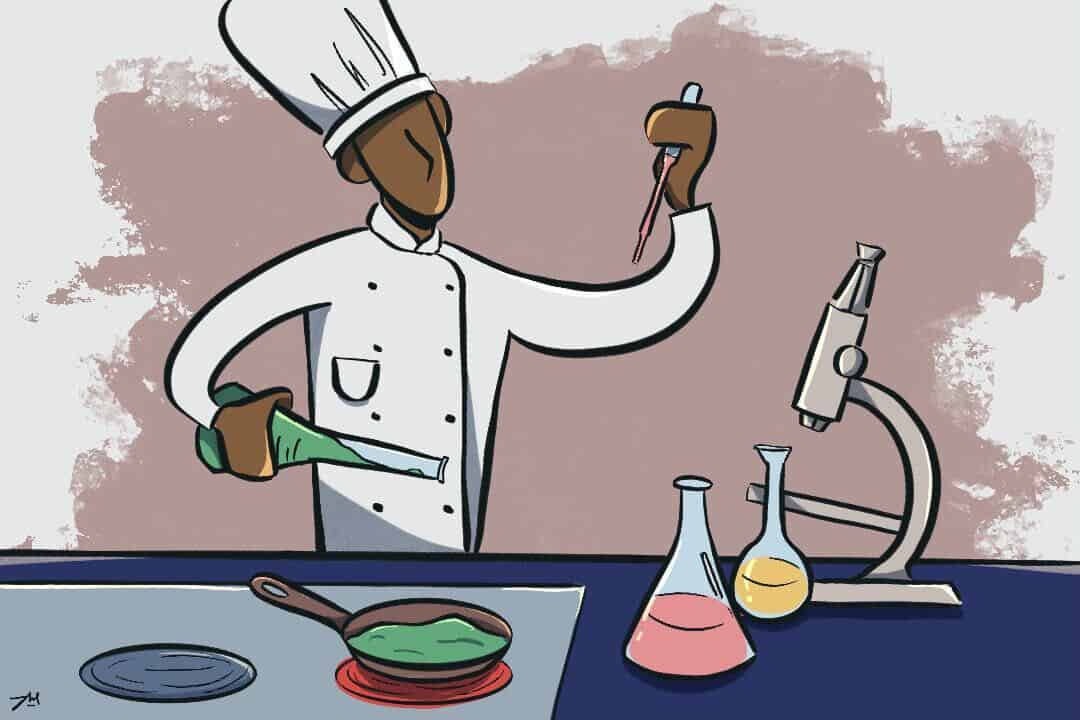I’ve always thought ‘molecular gastronomy’ sounds like a term made up by haute-cuisine chefs to make food science sound more intimidating.
However, its principles are pretty accessible. Molecular gastronomy is the idea that any technique in cooking — from heating and curing to stabilizing emulsions — can be optimized by looking at the physical and chemical properties of its component materials and understanding their interactions at a molecular level.
Food science approaches are based on classic techniques, but the literature on them can still be hard to get into. That shouldn’t be a barrier, though; anytime you’re making food, you can experiment with novel reactions and interactions!
Phases of matter: texture and gelification
Okay, here’s a trick for you: how can you turn a liquid into something that stays solid at room temperature? Well, easy — a gelling agent.
Gelification is a popular technique in molecular gastronomy because of how well it can be used for fancy food presentations. It’s really not that unusual; if you’ve ever used Jell-O or pectin, you’ve already experimented with gelification.
Gelling agents are added to liquids to make them thicker — sometimes, thick enough to hold their form as a solid. The mechanics behind gelling often have to do with temperature. Once cooled, gelatin protein strands associate with one another, which creates pockets that trap liquid inside, which can then be broken apart when reheated.
The uses of gelification go far beyond just Jell-O and sauces. There’s a long list of thickeners and gelling agents chefs can use to change the firmness or viscosity of something that starts off as a liquid, each with its own advantages and disadvantages based on the exact properties you’re trying to create.
One common, versatile, and easy-to-get gelling agent is agar agar — a substance derived from certain types of red algae. The reason agar is so versatile is, again, all because of temperature. Agar isn’t soluble except at high temperatures, so when it’s dissolved in a boiling liquid and then cooled, the resulting gel won’t melt in your hands or mouth while eating, since the human body’s temperature isn’t high enough to dissolve the gel.
Gelification has a variety of uses, such as thickening sauces or stabilizing foams. If you want to play around with the shape and form of your food, you can do so by controlling how your gel cools. To make pearls, you can drop bits of a liquid with dissolved agar into a tall container of thoroughly chilled oil; the agar-water solution will form a spherical shape as it falls, and will solidify because of the temperature of the surrounding oil. You can even pipe the solution into food-safe tubing with a food syringe, and then cool the tubing, to make noodles made out of the liquids of your choice!
How to make a crust: Taste and the Maillard reaction
Ever wondered why bread crusts turn brown in the oven or what happens when you sear meat? Many types of browning that we see in food happen at least in part because of one very common set of reactions, which you may have already heard of. The set of chemical processes known as the Maillard reaction is famous for its ability to create complex and developed flavours. It occurs not because of enzymes present in your starting ingredients, but because of a reaction happening between sugars and amino acids as the food heats up.
This reaction changes a lot of properties in the food you’re cooking and creates flavourful volatile compounds.
It’s also a great avenue for experimentation: knowing about the Maillard reaction may allow you to speed up the process to make flavours develop quicker or to avoid it if you weren’t looking for your food to change colour.
There are actually a few ways you can speed up or slow down the Maillard reaction. The effects of the reaction tend to happen at high temperatures of about 300 degrees Celsius — far above water’s boiling point, which is why you won’t get the same kind of flavourful browning on meat if you boil it. The acidity of your ingredients also plays a role in how fast or slow the reaction starts — lowering the pH of your food, or adding acid, can help you slow down the reaction whereas raising the pH, or adding a base, can help you speed it up. Just be sure you’re only adding food-safe ingredients!
This only scratches the surface of food science and molecular gastronomy. If you’re interested in learning more, Harvard University has published a series of online lectures on food science for a general audience, which you can access for free on YouTube. U of T’s nutritional science program also offers some courses on the mechanics of food, like NFS386 — Food Chemistry, which you can take after first-year chemistry classes.
But you don’t have to be a chemistry student to learn about what’s going on under the hood while you’re cooking. The field is as wide as our imagination; wherever there’s something to cook, you can bring in concepts from food sciences to understand it better. In the end, applying the scientific method to understand the processes behind making your food taste better at a molecular level isn’t just useful to improve your cooking — it can also be incredibly fun.


